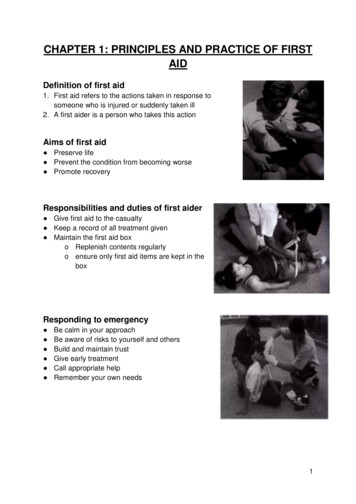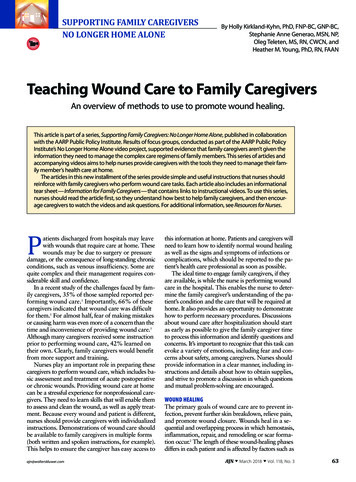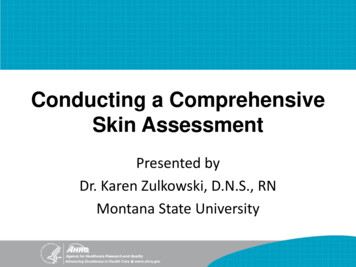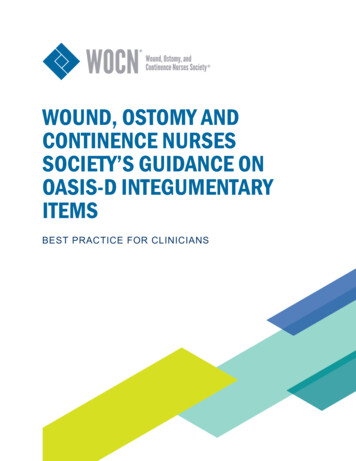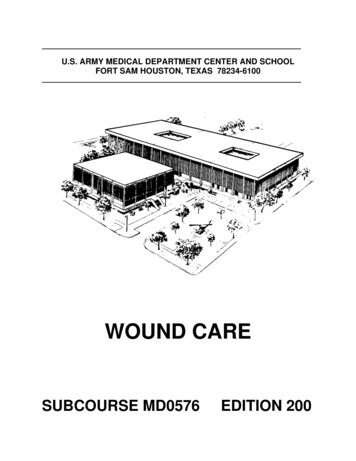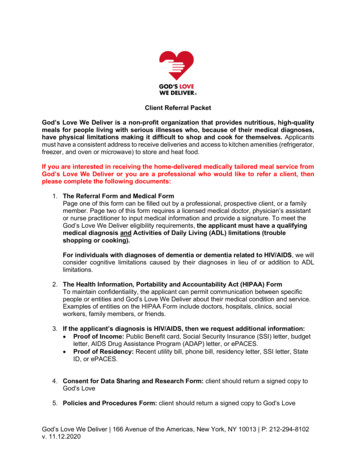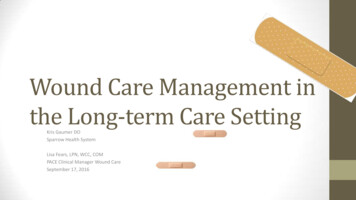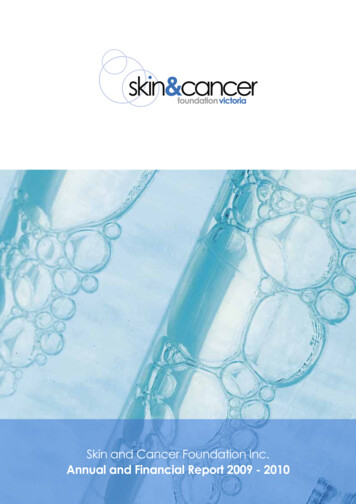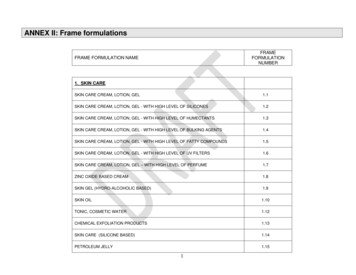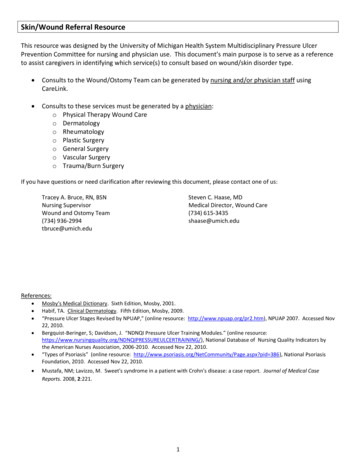
Transcription
Skin/Wound Referral ResourceThis resource was designed by the University of Michigan Health System Multidisciplinary Pressure UlcerPrevention Committee for nursing and physician use. This document’s main purpose is to serve as a referenceto assist caregivers in identifying which service(s) to consult based on wound/skin disorder type. Consults to the Wound/Ostomy Team can be generated by nursing and/or physician staff usingCareLink. Consults to these services must be generated by a physician:o Physical Therapy Wound Careo Dermatologyo Rheumatologyo Plastic Surgeryo General Surgeryo Vascular Surgeryo Trauma/Burn SurgeryIf you have questions or need clarification after reviewing this document, please contact one of us:Tracey A. Bruce, RN, BSNNursing SupervisorWound and Ostomy Team(734) 936-2994tbruce@umich.eduSteven C. Haase, MDMedical Director, Wound Care(734) 615-3435shaase@umich.eduReferences: Mosby’s Medical Dictionary. Sixth Edition, Mosby, 2001.Habif, TA. Clinical Dermatology. Fifth Edition, Mosby, 2009.“Pressure Ulcer Stages Revised by NPUAP,” (online resource: http://www.npuap.org/pr2.htm), NPUAP 2007. Accessed Nov22, 2010.Bergquist-Beringer, S; Davidson, J. “NDNQI Pressure Ulcer Training Modules.” (online UREULCERTRAINING/), National Database of Nursing Quality Indicators bythe American Nurses Association, 2006-2010. Accessed Nov 22, 2010.“Types of Psoriasis” (online resource: d 386), National PsoriasisFoundation, 2010. Accessed Nov 22, 2010.Mustafa, NM; Lavizzo, M. Sweet's syndrome in a patient with Crohn's disease: a case report. Journal of Medical CaseReports. 2008, 2:221.1
Skin Tear: traumatic skinloss at the dermal/epidermal junction due tofriction and/or shear; mayoccur when lifting orturning a patient,bumping into objects, orwith the removal of tapeor adhesive dressings.Incontinence-AssociatedDermatitis: aninflammation of the skinthat occurs when urineand/or stool comes intocontact with perineal orperi-genital skin. The areamay be red and/ordenuded. It may bepruritic (itchy) and/orpainful.Manage per Dressing SelectionGuidelinesConsult Wound/Ostomy Teamif concern arisesStage I Pressure Ulcer:intact skin with nonblanchable redness of alocalized area, usuallyover a bony prominence.Darkly pigmented skinmay not have visibleblanching; its color maydiffer from thesurrounding skin.Stage II Pressure Ulcer:partial-thickness loss ofskin presenting as ashallow open ulcer with ared/pink wound bed,without slough. May alsopresent as an intact oropen (ruptured) serumfilled blister.2
Suspected Deep TissueInjury: purple or maroonarea of discolored intactskin or blood-filled blisterdue to damage ofunderlying soft tissuefrom pressure and/orshear. The area may bepreceded by tissue that ispainful, firm, mushy,boggy, warmer or cooleras compared to adjacenttissue.Consult Wound/OstomyTeamStage III Pressure Ulcer:full-thickness skin loss.Subcutaneous fat may bevisible, but bone, tendon,or muscle are notexposed. Slough may bepresent, but does notobscure the depth ofwound. These woundsmay have undermining ortunneling.Consult Wound/OstomyTeam*------------*Wound/Ostomy Teamwill evaluate and mayrecommend one of thefollowing consults beplaced by the primaryservice:Stage IV Pressure Ulcer:full thickness tissue losswith exposed bone,tendon, and/or muscle.Slough or eschar may bepresent on some parts ofthe wound bed. Thesewounds often includeundermining andtunneling.Unstageable PressureUlcer: full thickness tissueloss in which the base ofthe ulcer is covered byslough (yellow, tan, gray,green, or brown) and/oreschar (tan, brown, orblack). The ulcer stagecannot be determineduntil this tissue isremoved.3 PT/Wound Careconsult for minordebridement andpulse lavage, or Plastic Surgeryconsult for surgicaldebridement
Dermatologic Lesions:This category includes superficial skin lesions,rashes, and a few unusual wounds that are besttreated by Dermatology. Their service will oftenperform a biopsy to confirm the diagnosis.Consult Dermatology(This consult must beplaced by a physician.)Skin RashesSkin Lesions (Nevi, Moles, Keratoses, Warts)Psoriasis: A common chronic skin conditioncharacterized by circumscribed red patchescovered by thick, dry silvery adherent scalesthat are the result of excessive developmentof epithelial cells. (photo: www.psoriasis.org)Sweet’s Syndrome: A condition usually seenon the upper body of middle-aged women,characterized by one or more large, rapidlyextending, erythematous, tender or painfulplaques, accompanied by fever and denseinfiltration of neutrophils in the upper andmiddle dermis. (photo: Mustafa, Journal ofMedical Case Reports, 2008)Pemphigus: An uncommon, severe disease ofthe skin and mucous membranes,characterized by thin-walled bullae arisingfrom apparently normal skin or mucousmembrane.Pyoderma Gangrenosum: A rapidly evolving,idiopathic, chronic debilitating skin diseasethat usually accompanies a systemic disease,especially chronic ulcerative colitis, and ischaracterized by irregular, boggy, blue-redulcers with undermined borders surroundingpurulent necrotic bases. This lesion canworsen with surgical debridement and isoften treated instead with systemic and/ortopical immunosuppressants. (photo: publicdomain)4
Deep Abscesses: A cavity containing pus andsurrounded by inflamed tissue; often detectedon CT or MRI; may require drainage by surgeryor interventional radiologyConsult General SurgeryNecrotizing Fasciitis: An infection of thesubcutaneous tissue that results in thedestruction of fascia and fat; often spreadsrapidly along the deep fascia; typically treatedas a surgical emergency(This consult must be placedby a physician.)Fournier’s Gangrene: An infective gangrene ofthe scrotum or vulva caused by an anaerobichemolytic strain of streptococcus.Burns: An injury to the tissues of the bodycaused by hot objects or flames, electricity,chemicals, radiation or gases; depth of burndetermines need for surgical intervention; oftenrequire intensive wound careConsult Trauma/Burn(This consult must be placedby a physician.)Large Desquamating Wounds: Stevens Johnson Syndrome: A serious,sometimes fatal, inflammatory diseaseaffecting children and young adults. It ischaracterized by the acute onset of fever,bullae on the skin, and ulcers on themucous membranes of the lips, eyes,mouth, nasal passage, and genitalia. (photo:public domain) .Toxic Epidermal Necrolysis: A rare skindisease characterized by epidermalerythema, superficial necrosis, and skinerosions.Wounds Due to Autoimmune Disorders: Vasculitis: Inflammation of the blood vessels;may be caused by a systemic disease or anallergic reaction. Some vasculitic diseaseinvolves only the skin, while others mayinvolve vessels in different organs. Systemic Lupus Erythematosus: A chronicinflammatory disease affecting many systemsof the body. May present with skin rash orlesions; often a “butterfly rash” over nose andmalar eminences is noted. Scleroderma: Chronic hardening andthickening of the skin caused by new collagenformation, with atrophy of pilosebaceousfollicles.Consult Rheumatology(This consult must be placedby a physician.).5
Wounds Due to Arterial or Venous DiseaseExamples include: Pulseless extremities Arterial Ulcers: Wounds caused byimpaired arterial blood flow, usually to thelower leg and foot, which leads to tissueischemia, necrosis and loss.Ulcer characteristics include:o Well-defined margins or “punched out”appearanceo Minimal exudateLegs with ischemic disease may have:o Cool skino Shiny skino Decreased or absent pulseso Abnormal vascular studieso Pain Venous Ulcers: Wounds caused by adecrease in blood flow return from thelower extremities to the heart; theunderlying cause is usually damaged orincompetent veins. Venous wounds areusually located on the calf or ankle.Ulcer characteristics include:o Irregular marginso Shallow deptho Minimal paino Moderate to heavy drainageLegs with venous disease may have:o Brownish discoloration of lower legso Edemao Dry skinConsult Vascular Surgery(This consult must beplaced by a physician.)6
peri-genital skin. The area may be red and/or denuded. It may be pruritic (itchy) and/or painful. Manage per Dressing Stage I Pressure Ulcer: intact skin with non-blanchable redness of a localized area, usually over a bony prominence. Darkly pigmented skin may not have visible blanching; its col
